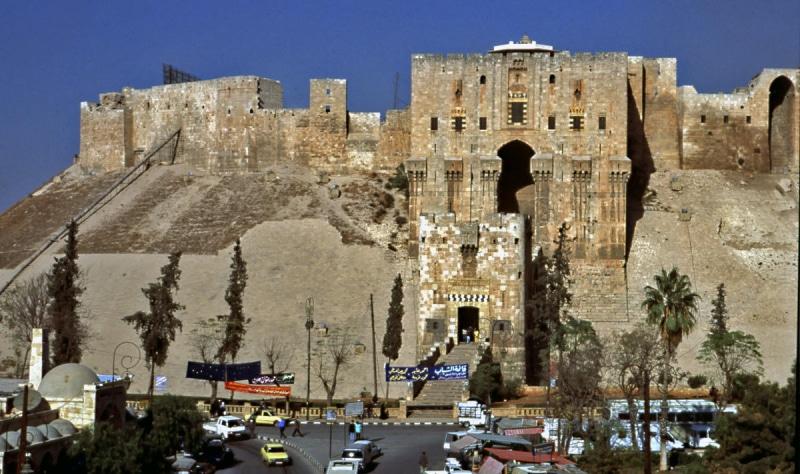ArtGalleries, Syrian Arab Republic

Removed from Unnamed collection
National Museum of Aleppo 
The earliest collection of art and archaeological artefacts for the National Museum of Aleppo dates back to 1928 and the museum was formally inaugurated in1931. Initially, it was devoted to the pre-Greco-Roman era, with works no later than 333 BC, most of which were based on finds from Tell Halaf. It was decided to move the collection from its original location in an Ottoman period building, which had become overcrowded, into a modern purpose-built museum, begun in 1967 and formally opened in 1972. It includes the following wings:
Pre-historic art: dedicated to finds such as bones and pottery from the regions of Syria and the Euphrates Valley. Some items are about a million years old and the most recent piece dates to no later than 3,200 BC, after which writing was developed and art, became historic.
Arab Islamic art: The method of display here is based on the item's function and medium, such as pottery, ceramics, metalwork and glass of the various Islamic dynasties as well as a collection of gold and silver coins of the Umayyad, Abbasid, Ayyubid and Mamluk periods. A stone cenotaph carved in floriated kufic calligraphy is a masterpiece of this hall. Medieval military equipment and an Ottoman wooden ceiling featured in a side chamber are also presented.
Modern art: paintings by Syrian artists, particularly Aleppines, expressed in various styles such as realism, cubism, expressionism. http://www.discoverislamicart.org/pm_partner.php?id=Mus01_A;sy&type=museum&theme=ISL
Map

Removed from Unnamed collection
Aleppo Castle 
One of the oldest continuously inhabited cities in the world, Aleppo preserves remnants of more than four millennia of Near Eastern history. The Citadel of Aleppo is a densely layered microcosm of this long and complex history. The majority of the structures on the citadel were erected by the Ayyubids in the twelfth and thirteenth centuries, but substantial structures are also preserved from the Ottoman period (beginning in the sixteenth century). The citadel was built on a natural limestone outcropping rising some 100 feet (30 meters) above the level of the surrounding plain. Its high walls, imposing entry bridge, and great gateway remain largely intact and dominate the skyline of the city. Within its walls, the fabric of the citadel’s inner spaces has been compromised by a succession of invasions, earthquakes, and natural decay caused by exposure to the elements. Recent excavations uncovered substantial remains of an important Bronze Age neo-Hittite temple, in use for the most part of the third and second millennia B.C. The temple is decorated with an elaborate system of reliefs that depict deities and fantastic creatures and that are an important addition to the record of this early period in Syria’s history. https://www.wmf.org/project/citadel-aleppo
Map

Removed from Unnamed collection
Great Mosque of Aleppo 
The Great Mosque of Aleppo is situated in the center of the city. The construction of the building dates ta the Omayyad period. The building has, however, undergone numerous repairs and changes before taking its present form.
it was built approximately 1 O years after the Damascus Omayyad Mosque, and as such, is one of the first buildings of the early period of Islamic architecture. The mosque is situated in a commercial district, with bazaars and several madrasas nearby.
Several buildings belonging ta the pre-Islamic period, including a Roman temple and a Byzantine church, were located near the mosque, and their remains can be seen today.
The mosque has been altered by many repairs and renovations. In 715, the Omayyad Caliph Sulayman ibn Abd al-Malik commissioned the construction of a Friday Mosque on the site of a cathedral. Aleppo and its surroundings were attacked by the Byzantine Emperor Nikephoros il in 926. The building, damaged as a result of this attack, was repaired by Seyfuddevle al-Hamadani in 965. lıWıen the Great Seljuks ruled the region, the Sultan Malik Shah commissioned an important restoration campaign, and also added the minaret to the mosque. Repair and renovation activities were carried out in 1090 during the reign of his brother Tutus. One of the oldest parts of the building is the minaret. The minaret, with a square body, is remarkable tor its Kufic inscription bands, stylized plant and Rumi decorations, and stalactites. http://www.selcuklumirasi.com/architecture-detail/aleppo-great-mosque#
Map

